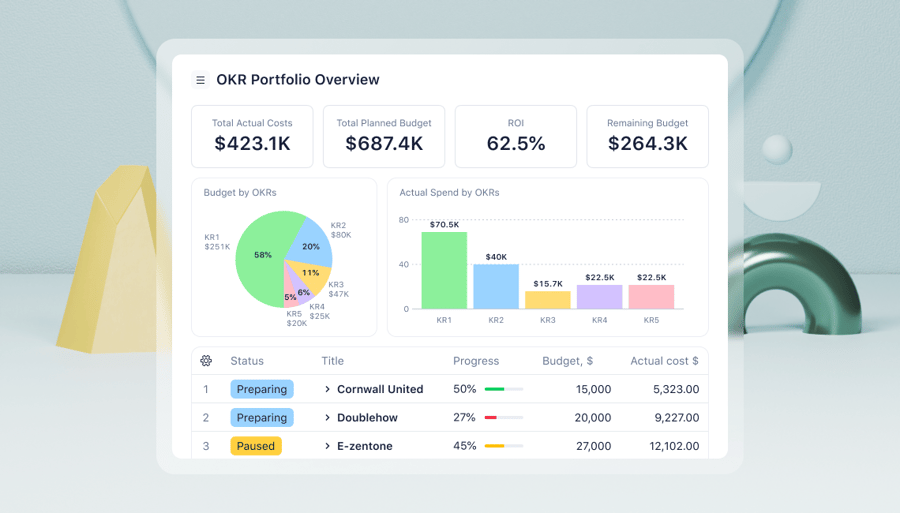Key takeaways:
- What is an annual plan? An annual plan outlines a company’s goals and milestones for the upcoming year, guiding operations and performance.
- Why is annual planning important? It aligns team objectives, motivates employees, and drives overall performance.
- What should be included in a strategic annual plan? Key components include performance analysis, budget estimations, a clear vision statement, SMART goals, and contingency plans.
- How can SMART goals enhance planning? SMART goals provide specific, measurable targets, helping teams track progress and attain success.
- How can Wrike assist with annual plans? Wrike helps streamline project management, ensuring accountability, flexibility, and collaborative input in developing strategic plans.
The first step to achieving goals is to come up with an annual plan. A strategic annual plan makes it easier for managers, team leaders, and company owners to execute their vision for growth. Not only does creating an annual plan give you time to reflect on past accomplishments, but it’s also a great way to make ideas actionable. Keep reading to learn more about what annual planning is and how you can create one that has a significant impact on your organization.
What is an annual plan?
An annual business plan is a set of goals and milestones that guide a company’s operations for the year ahead. It helps guide employees and investors in the right direction. For many people, this year’s new year begins with a review of their previous year. They then set goals and make plans for the coming year.
Annual planning is a combination of two other important elements: a business plan and an annual plan.
A business plan is a document that a company or organization uses to set goals and improve performance. It’s similar to a belt-tightening exercise.
An annual plan is a strategy that a company uses to set goals and expectations for the coming year. It helps employees visualize where they are headed and how they can get there. The annual plan also sets out a company’s long-term goals and helps guide how it will reach these targets.
An annual business plan helps workers set goals and holds them accountable for achieving those goals for the upcoming 12 months.
Then, there’s strategic planning. A strategic planning process helps an organization identify its mission, vision, and strategic goals.
The strategic plan combined with the annual business plan are two key components of a successful strategy. The former provides a framework for the company’s goals and intentions, while the latter provides the necessary tools and processes to execute those goals.
Overview of a strategic annual plan
Here is what is typically included in a strategic annual plan:
- Analysis of past performance. Reviewing your goals can help you identify areas where you can improve and become more productive.
- Budget estimations. Financial projections are often included in budget planning. They help you plan for the coming year and identify the right course of action for your projects.
- A clear vision statement. Expectations must be clearly stated, as well as responsibilities and clear OKRs. Having these elements in place can help keep teams on track and motivated.
- SMART goals. Set specific, measurable goals and deadlines for your company. This will help you measure how far you’ve come in terms of meeting the key results.
- Buffer room. A well-written annual plan should include space for emergencies as well. Having a contingency plan can help avoid unexpected expenses.
In a nutshell: the annual plan is a strategy used to plan and execute the organization’s goals and objectives. It is usually composed of three phases which are strategy, projects, and timing.
The importance of an annual plan
Annual planning helps define what’s important to achieving goals and driving performance. An annual plan also helps keep the workforce united and can be used to motivate and retain employees.
A well-written annual plan can help you set the direction for your company while providing the team with a sense of direction.
Examples of annual strategic planning
Here are some ideas to get you started with your own strategic annual plan:
1. Coca Cola HBC 2020 Integrated Annual Plan
Coca-Cola’s 246-page report details all aspects of their business. They start by celebrating their wins with statistics. They also include photos of actual customers and partners. Their CEO writes a letter to their stakeholders sharing their biggest accomplishments over the past year.
Then they go through their vision. Throughout the strategy, you can see that they are using the pillar method for goal planning. Key areas of focus include leveraging existing business, continuing to win the beverage marketplace, making competitive investments, focusing on employee growth, and expanding their licensing.
The overall report is designed well and is reminiscent of a well-crafted white paper. Because the CEO’s letter was addressed specifically to stakeholders, we know that this is a tool for increasing investment as well as project planning. Because of this, a lot of the content within it answers the question, “why should I invest in you?”
Throughout the rest of the annual plan, each pillar gets its own section. At the top of each section, there is a list of accomplishments from the past year and priorities for the coming year. They also summarize risks, stakeholders, and KPIs. This makes the packet easy to skim but also easy to remember.
2. pep+ (PepsiCo Positive)
PepsiCo recently announced that their new 2022 initiative will revolve around “the planet and people.” While this is a long-term process for the brand, the launch will mark the core of their strategic annual plan for the foreseeable future. Their keywords include positivity (hence the “+”), sustainability, and “a fundamental transformation of what we do and how we do it.”
On their dedicated landing page, readers can dig deeper into their annual plan. Also well designed, this presentation shows what the future looks like for PepsiCo through refreshed branding and imagery. Symbols such as smiling farmers and healthy, green fields drive the message home.
To achieve these new goals, the company will focus on supply chains, inspiring consumers, and driving sustainable change among all its product lines.
They link several documents throughout the report, including a comprehensive list of goals which is a great example for your own annual plan template inspiration. This three-page chart names pillars on the left-hand side and targets or actions with due dates on the right.
If their goals have numerical metrics, they include data from past years, along with key benchmarks they hope to reach by the end of the year or in the future. Otherwise, their goals are measured in actions.
For example, as part of their sustainability pillar, they plan to “develop and deploy disruptive sustainable packaging materials and new models for convenient foods and beverages.” This task is specific and clear, despite the fact that it’s not as quantifiable as some of their other goals.
3. Nestlé Global’s Annual Report
Their annual plan is not public but they have shared an annual report on past wins from 2020. In addition to a financial review, Nestlé also shares a new strategy. Starting with important facts and figures the company highlights statistics from organic sales growth and more. They also visualize data about which types of products are selling most and where in the world the company has grown over the past year.
As Coca-Cola did, Nestlé also includes a letter to shareholders. They discuss ways in which they plan to grow in the coming year. This includes what product areas they will invest more in and where they will pause or halt efforts. They also emphasize a new product area which will be the focus moving forward in the short term. In this section, Nestlé touches on long-term strategies and how these short-term goals will affect them.
In general, their annual report focuses on the word innovation. It mostly has to do with developing new products and revamping old ones. Like PepsiCo, they are using sustainability as a pillar as well as e-commerce.
The report goes on to elaborate on each strategy individually. Nestlé lists action steps and provides clear evidence as to why each is important. They also highlight statistics for growth in key areas and name even bigger numbers for where they hope to be in a year.
Throughout the report, they include images from ad campaigns that demonstrate the change they wish to continue implementing as part of their marketing plan. Again, branding imagery makes a big difference when creating your own strategic annual plan. It sets the tone for what’s written on the page and can help visual learners better understand what you’re going for at a glance.
Although Nestle’s strategic annual plan is designed more like a white paper than a chart, this layout is the most magazine-like by far. It serves as a great example of how you can organize ideas on the page in a way that is interesting and attention-grabbing.
One of the most notable aspects of their annual plan is the Materiality Matrix. They use this chart to visualize key areas of interest and prioritize them according to stakeholder values. Within each box, they’ve listed bullet points of business areas this value will impact. It’s a great method for summarizing goals that cover a wide variety of departments and business engagements.
Understanding strategic planning best practices
Everyone has their own way of thinking about annual plans. Regardless of what you’re trying to achieve, the following strategic planning best practices will help you get there:
1. Use SMART goals
A variety of SMART goals are commonly used to help guide and motivate people. They help set realistic benchmarks and are designed to help teams achieve success. It will also help you plan for the ups and downs of your business. To reach your goals, divide them up into smaller goals and set specific deadlines. These goals will help you measure how successful you are at reaching them.
2. Include contingencies
For example, having an emergency financial reservoir is a good idea to prevent a potential financial disaster. It can help your company navigate slower seasons while still sticking to your annual plan.
3. Build in flexibility
Even minor shifts in external factors can significantly impact on how effective you are at creating and implementing your strategic plan. Never forget that, while we are creating our annual plans in a vacuum, the world will undoubtedly go through more changes this coming year. Even though we can’t predict the future, we can make our plans foolproof by being flexible now.
What is an annual plan template?
An annual plan template is a document or tool that can be utilized repeatedly to outline the various stages involved in creating an annual plan.
Its purpose is to provide a clear understanding of the annual planning process by specifying the actions to be taken and the timeline to follow in order to develop an effective business plan. By utilizing the annual planning template, individuals or organizations can ensure that they have a systematic approach to reaching specific goals, and can enhance the quality of their business plans.
Using Wrike to assist with an annual plan template
Wrike’s project management software can help you keep track of all your company-related information in one place. It can also streamline your work and help you stay on track. It can also help you keep track of your annual plans and develop a strong strategy.
Start by using last year as a reference. By understanding the issues that affected the previous year, a company can improve its performance in the following year.
Draw reports of time spent per project and see where your team went over or underestimated. Then look at which tasks tend to drain resources the most. Determine whether or not the ROI is worth it moving forward.
Next, set realistic goals. Reflect on last year’s statistics from Wrike Reports and put together a plan with a realistic metric for improvement.
After, break down big plans into individual steps. Start by focusing on the business goals of the company then outline your key objectives that align with those. Make sure that everyone knows who is responsible for executing and approving each task.
Draft a Gantt chart that includes each step broken down into relevant tasks. Remember to add deadlines to every action to keep teammates accountable and keep to realistic deadlines.
Then, delegate tasks according to strengths and weaknesses. Use project reporting and individual job performance to assess team members. You may find that those with specialized talent are being tasked with unskilled work when they could help solve major problems elsewhere.
Don’t forget to involve the whole team. Start early, plan ahead, and keep everyone involved in the process. Doing so will make it easier to overcome obstacles once the projects are underway.
Additionally, ask them for direct feedback on your ideas for the next year. You will learn from the front line what obstacles they may be facing that will affect the timeline.
Another bonus of getting your team involved is that it creates more transparency in the workplace. Using Wrike as a part of the process is not only helpful, but the team also keeps learning how to use the system more efficiently as they go.
Having a work management platform that enables you to plan and execute annual plans is a good idea. Plus, it’s also a good idea to use tools that allow you to collaborate and manage complex processes. Create an effective annual plan today with Wrike’s free trial.









